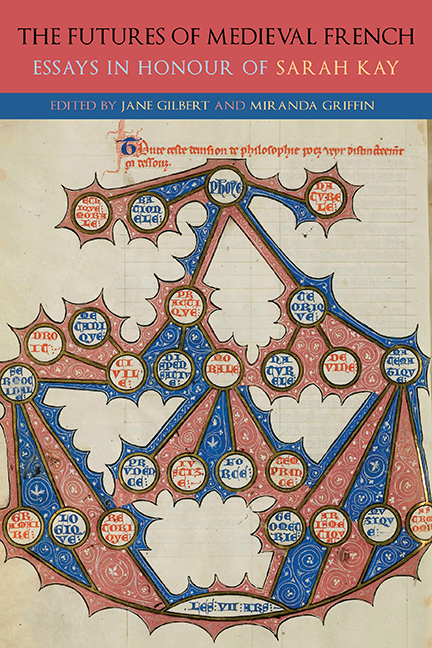Book contents
- Frontmatter
- Dedication
- Contents
- List of Illustrations
- List of Contributors
- List of Abbreviations
- Introduction
- Part I Subjectivity in Troubadour Poetry
- Part II The ‘Chansons de geste’ in the Age of Romance: Political Fictions
- Part III Courtly Contradictions: The Emergence of the Literary Object in the Twelfth Century
- Part IV The Place of Thought: The Complexity of One in French Didactic Literature
- Part V Parrots and Nightingales: Troubadour Quotations and the Development of European Poetry
- Part VI Animal Skins and the Reading Self in Medieval Latin and French Bestiaries
- Afterword
- General Bibliography
- List of Manuscripts
- Bibliography of Work by Sarah Kay
- Index
- Gallica
Introduction
Published online by Cambridge University Press: 27 May 2021
- Frontmatter
- Dedication
- Contents
- List of Illustrations
- List of Contributors
- List of Abbreviations
- Introduction
- Part I Subjectivity in Troubadour Poetry
- Part II The ‘Chansons de geste’ in the Age of Romance: Political Fictions
- Part III Courtly Contradictions: The Emergence of the Literary Object in the Twelfth Century
- Part IV The Place of Thought: The Complexity of One in French Didactic Literature
- Part V Parrots and Nightingales: Troubadour Quotations and the Development of European Poetry
- Part VI Animal Skins and the Reading Self in Medieval Latin and French Bestiaries
- Afterword
- General Bibliography
- List of Manuscripts
- Bibliography of Work by Sarah Kay
- Index
- Gallica
Summary
I WANTED TO BEGIN this introduction by pointing out that Courtly Contradictions is nothing less than a new account of medieval literary history. But then when I looked at Sarah Kay's publications as a group – a perspective this volume invites – I realised that this description could apply to almost all of her major projects. Here, as elsewhere, her claims are not merely about formal change or about influence, but about ways of thinking with and through literature, elucidated through medieval philosophy and modern psychoanalysis. In Courtly Contradictions, Kay turns to the twelfth century, investigating the development of courtly literature as literary entertainment and arguing for the role of contradiction in this development. Contradiction lay at the heart of twelfth-century intellectual life, she points out; it was both an object of thought and a mode of thinking. As such, contradiction shaped literary texts, and in enduring ways. The success of courtly literature, she suggests, ‘may lie in the way the contradictions which it embodies appeal to the contradictoriness of our own impulses and desires’ (37). And the signal innovation of Courtly Contradictions is the exploration of medieval philosophical traditions in tandem with modern psychoanalytic understandings of the formation of the subject, particularly in relation to its objects.
Courtly Contradictions may be Kay's most Lacanian book; it is certainly one of her most challenging, moving not just between medieval philosophy and modern psychoanalysis, but also among genres and across the twelfth century with a series of readings that structure a claim about the development of courtly literature. In the first instance, Courtly Contradictions demonstrates how the courtly genres of lyric poetry, hagiography, and romance move between Augustinian and Aristotelian understandings of contradiction, that is, between an Augustinian understanding of contradiction as possible within a higher unity, and the Aristotelian principle of noncontradiction whereby neither contradictory nor contrary statements can be true of the same thing at the same time. Kay shows that, under the influence of secular logic, literary texts become less caught in oppositions and more able to play with complex chains of reasoning; they became less invested in resolution and more engaged with argument for its own sake.
- Type
- Chapter
- Information
- The Futures of Medieval FrenchEssays in Honour of Sarah Kay, pp. 115 - 118Publisher: Boydell & BrewerPrint publication year: 2021

